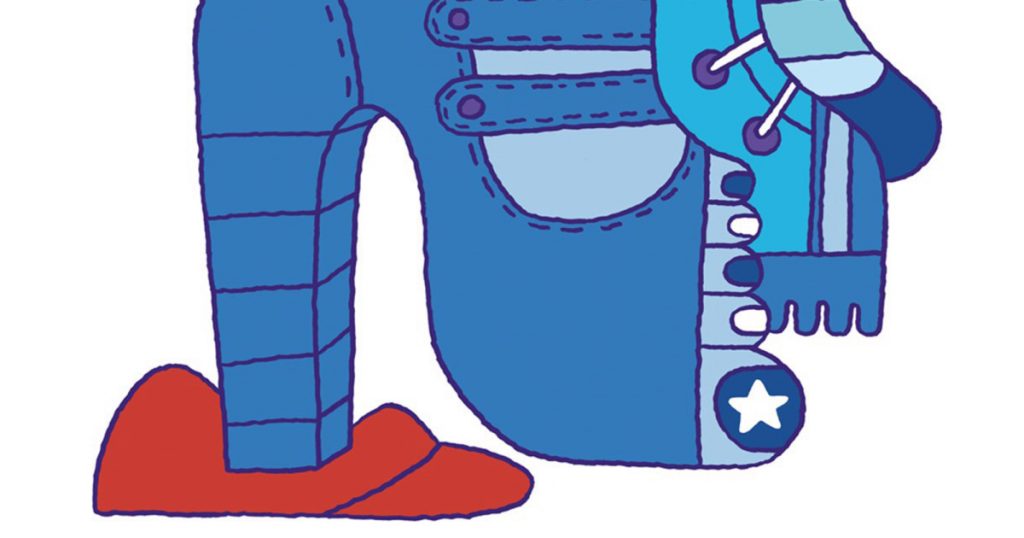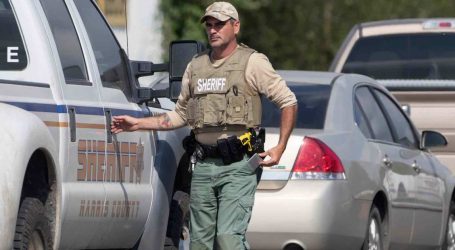What’s Next for the #Resistance Now That They Don’t Have Trump to Kick Around Anymore?
Melinda Beck
Let our journalists help you make sense of the noise: Subscribe to the Mother Jones Daily newsletter and get a recap of news that matters.“You’ll see the signs :),” Megan Bartlett had texted me as I looked for her house in Geneva, Illinois, a 20,000-person town about an hour west of Chicago. The note seemed vague to the point of useless until I arrived. In a maze of massive greige colonials, Bartlett’s stuck out: It was the only one bedecked with campaign signs for various local Democratic candidates. It was a Sunday morning in October 2018, and I was reporting on Rep. Lauren Underwood, a nurse turned Obamacare expert waging an underdog bid to unseat the district’s Republican representative. Bartlett, a 34-year-old music teacher, had been described to me as “the organizing brain and communications expert” of the grassroots supporting Underwood’s bid.
When I entered Bartlett’s home, I met half a dozen women gathered at the dining room table for breakfast before a day of door-knocking for Democratic candidates. Most of the organizers were a bit older than Bartlett, each of them white, and all, like Bartlett, had become newly engaged in politics since Donald Trump’s 2016 victory. Over plates of eggs, bacon, and scones, I peppered them with questions about Underwood’s prospects. But they were more eager to tell me about what was happening down ballot—the candidates for county board, school board, and sheriff in Kane County, where Geneva is the seat. “Lauren’s race is really important,” Tina Willson told me. “The reality is she’s not really the one who affects our day-to-day lives as much as a lot of other people.”
The Ballad of the Resistance goes something like this: Trump’s win sparked the political consciences of a particular slice of American women—often white, privileged, and well educated. They marched, lobbied Congress to push back against Trump, and, when that failed, flipped House seats, including the one Underwood won. Four years later, there’s a Democrat heading to the White House, and the Democratic House majority remains in place.
But for women like Bartlett, the bigger change may be on the local front. Across the country, the women radicalized by Trump’s election have followed a path similar to the one that Bartlett and her fellow neophyte organizers have taken: They’ve reinforced the local Democratic infrastructure, built a bench of new Democratic officeholders, and channeled the fury of the anti-Trump movement into their local communities—and have done so in the face of local parties and elected officials (usually men) who dismissed their efforts as fleeting or frivolous.
Harvard sociologist and political scientist Theda Skocpol found that at least 2,500 women-led resistance groups have formed since the 2016 election, a number that doesn’t account for women who have simply become key players in local Democratic politics. Lara Putnam, a historian at the University of Pittsburgh who has collaborated with Skocpol in tracking the resurgence of women’s grassroots activism, says that although Trump was the spark, the work in their own communities is what will keep these activists going. “People have become very involved in these networks that have carried new people into office and party positions,” Putnam says. “What keeps me confident that they’re going to stay engaged isn’t the attention to the national level—it’s the way they’re involved in local and regional politics now.”
When Bartlett was growing up, her family never talked politics, and she had no idea who her parents voted for. That wasn’t uncommon in Kane County, one of the five suburban “collar counties” outside Chicago. Its population is 86 percent white, and many residents are “Republican by habit,” one of the women at Bartlett’s house told me. Conversations about politics were considered impolite—as was placing political signs in front of their houses.
Accordingly, most of the women gathered around Bartlett’s table hadn’t known each other before Clinton’s loss. They were among those who had shuffled, devastated and disoriented, to their local Democratic Party meeting and the first gatherings of myriad local #Resist groups that materialized overnight. Among the throngs of the newly enraged, the women identified one another as those who might stick it out for the long haul. “We started finding people who were doing things—like, actually, doing things—as opposed to just complaining about Trump,” Willson says. They began meeting every Thursday for drinks after the weekly Kane County Democrats meeting.
Bartlett’s first foray had been a Women’s March Huddle she started with a friend from high school after they attended the main march in Chicago. Someone had brought an Indivisible guide—the viral how-to for constituents to hold their members of Congress accountable—and they founded one of the group’s many chapters. But Bartlett quickly realized she was much more interested in local politics. “The only thing you have control over, really, is your own neighborhood,” she says.
A friend ran as a write-in candidate for the local library board and won. Her campaign was the first time most of them had ever canvassed, and to their shock and delight, she won. They filled out the ranks of Democratic precinct committee people, going door to door in their neighborhoods. “This sounds like a pretty good idea because no one has ever knocked on my door,” Bartlett tells me, who in 2018 became secretary of the Kane County Democrats. Others decided to run for office themselves, angling for county board. Some of the Resistance newcomers Bartlett worked with closely took paid roles in the reelection campaigns this year of Underwood and Rep. Sean Casten in the district next door.
That bridge strengthened the relationship between the new activists and the longtime Democratic Party hands who had initially viewed the grassroots with suspicion. One of the women at Bartlett’s house recalled a man in charge of the local party saying, “We’re still going to be the ones who are here when you guys all get tired of it and go.” But they didn’t go, and the old guard has come to both trust the newcomers and appreciate how they’ve helped the party grow. In March, Bartlett received an award from the party chair for her exceptional volunteerism.
These women also began translating national issues into local action. Paula Merrington, one of Bartlett’s allies, works with a group called Fox Valley Activists, which like many others founded in early 2017, served as “a place to grieve more than anything else, initially,” Merrington says. The group led local Black Lives Matter protests in the wake of George Floyd’s killing, joined a community conversation with the local chapter of the NAACP, and fought to get a public housing development in Geneva. Merrington says she’d always been involved in “big picture stuff,” but “I’ve come full circle to realize that local stuff—it’s just as impactful in daily lives than the national stuff.” “That’s a really common thread to all of these [activists],” says Amanda Litman, the founder of Run for Something. “They use their national anger to focus on local issues.”
Three weeks before the 2020 election, I caught up again with Bartlett’s group, this time over Zoom, when their story felt like it was rushing toward its inevitable, happy ending. Kane County, for the first time, had a full slate of Democrats running for every local position but coroner. All but one of the candidates running for county-wide positions were women, and they were being supported by a woman-heavy army of volunteers. Merrington was managing the state house campaign of Martha Paschke, a friend of hers from Fox Valley Activists. Bartlett could hardly keep up with the requests for yard signs for Democrats; a shipment of 2,000 had been depleted nearly as soon as it had arrived.
But the outcomes on Election Day didn’t match their expectations. Karina Villa, the Democrat who they helped to win an Illinois House seat in 2018, would end up flipping a state Senate seat. Underwood eked out a narrow victory. The Kane County Board flipped from majority Republican to Democratic control, and the county board chairmanship also switched from red to blue. But Paschke, Merrington’s candidate, lost, and the victories had been narrow, results that left Bartlett and her circle dumbfounded. “I think we were all living in this little fantasy world of like, there’s going to be another blue wave and we’re gonna just sweep all our races,” she says. “I guess the reality is the voters just aren’t there,” Merrington mused.
What does the future hold for these groups with Trump off the ballot? They’ll keep going, as Putnam says, on the strength of the structures and relationships they forged. “People have built a habit, especially these women, and built social groups and ties around political engagement and activism,” Litman says. “That’s what infrastructure is—it’s those relationships. Those relationships built over the last four years don’t go away after Election Day.”
But that isn’t to say that losing Trump won’t have some kind of demobilizing effect—particularly on the army of volunteers required to carry out the thankless work democracy requires. White women-led political movements from the past offer some clues as to how these movements evolve and sustain themselves—or whither away. Western Carolina University professor Elizabeth McRae says that the 20th century Southern segregationist women she studied just kept finding new outlets for their values: opposition to school integration, for example, flowed into opposition to sex education. Stacie Taranto, a historian at Ramapo College, tells me the white Catholic women who fought to stop the Equal Rights Amendment and access to abortion stopped organizing once their platform found a home within the Republican Party. “People tend to organize in the face [of] what they see as a threat,” she says.
Lily Geismer, a historian at Claremont McKenna College who studied liberal white women’s activism in the Boston suburbs during the 1960s and 1970s, pointed to an apt comparison to today’s resistance groups: A campaign in Massachusetts that got voters to endorse a state ERA in 1976, but that withered when activists tried to pivot to welfare rights and universal health care. “One of the lessons is that it is often easy to galvanize support and even activism in opposition to something—be it Phyllis Schaflly and the Stop ERA troops or Trump,” she tell me. “It’s harder to sustain suburban activism around causes that don’t have a direct impact and are trying to address more material and structural forms of inequality.”
Merrington has seen this play out in her group. “Everyone was riled up after Hillary, and then they got riled up after George Floyd,” she says, “and then they go back to their daily lives.” Bartlett similarly recalls meeting a ton of first-time activists in the wake of Trump’s victory who quickly disappeared, only to reemerge again as volunteers in the final weeks of the 2020 election. “Trump was the cause the first time and he is the cause again,” she says. “So if there’s no Trump anymore, are we gonna keep getting those volunteers? I don’t know.”
“I don’t blame them—I’m exhausted,” she adds. “I think a lot of other people are exhausted.” Yet Bartlett has no time to rest. She’s already looking to fill out the Democratic slate for the upcoming Board of Education elections and has taken a position with Illinois’ largest teachers union to exert grassroots pressure on the state legislature.
“There is one tiny shred of goodness that came out of all of this,” Bartlett says. “And it’s really just that”—she pauses, a satisfied smile emerging—“I feel like I have so much purpose now.”




